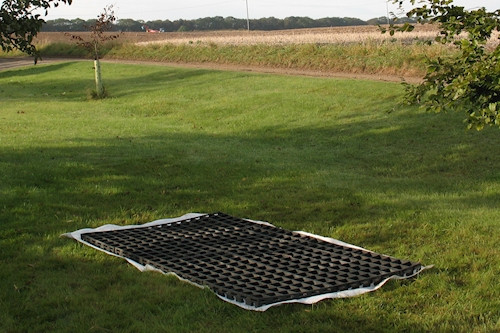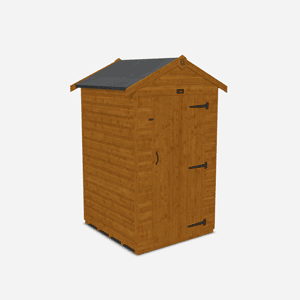How to Waterproof a Shed
Published: 16/09/2021

Whatever you use your shed for, there are many reasons you’ll want to ensure it’s waterproof. And that's why we’re showing you how to waterproof a shed throughout this post. To help you create a waterproof shed, the questions we answer in this post include:
- How do you waterproof the inside of a shed?
- What is the best way to waterproof a shed roof?
- How do I waterproof my shed walls?
- How do you keep a shed damp free?
We answer some of the questions above in specific sections, while answer others by referring to them throughout the post. So, whether you have leaking shed walls or want to prevent them, this is the guide for you. Note: This guide relates to tips on how to waterproof a wooden shed (not metal or plastic sheds). The information also applies whether you want to create a large or small waterproof shed.
The importance of shed waterproofing
Waterproofing your shed helps keep both the garden building and its contents in good condition. Why? Because too much moisture can rot wood (especially if left untreated). It can also lead to the build-up of mould and mildew, which, in turn, can create unpleasant smells and can irritate your skin, lungs, nose and throat. In addition, moisture can rust your metal tools. Whether you want to use your building for storing tools, or you want to create a garden gym shed, or anything else, we aim to provide all the information you need…
1. Start with the right shed

Before you get started on putting these tips into action, we need to make sure you have the right shed for the job. So, if you have an old shed with distorted window cavities and a hole in the roof, you should consider buying a new shed. Doing so might cost you more initially, but there’s no doubt it’ll also save you more money in the long run. The best sheds are made from shiplap – an upgraded type of tongue and groove cladding for sheds. These interlocking shiplap boards slot together with a tight fit to make the whole shed more resistant to rain and moisture from the air. So, if you’re starting with a tongue and groove shed as your base, you’ll be at an advantage. That said, to provide the ultimate protection from rain and other sources of moisture, you should still follow the rest of the tips in this guide…
2. Lay the right base

All garden buildings need a base. And one of the reasons for this is the way in which your shed will become damp more easily if it sits directly on the ground. You can build your own base by following our guide on how to build a shed base, or you can buy a plastic shed base – an eco-friendly alternative to a concrete shed base. Both concrete bases and plastic bases help waterproof your shed. As a watertight foundation, a concrete base helps keep your shed clear of groundwater seepage. But to improve waterproofing even further, you could use a waterproof membrane for your shed base. The best plastic base kits also boast waterproofing features. For example, the EcoBase Fastfit Base Kit uses a honeycomb structure to stop rainwater from puddling under the shed.
3. Treat the shed with wood preserver (or waterproof shed paint)

One the best ways to prevent leaking shed walls is to treat them with wood preservative at least once every 12 months. This is the case even if you own a shed that comes with a 20-year guarantee. While dip-treated sheds are initially protected (particularly during transit), the wood will weaken over time if left untreated. As a result, you should treat your built with a high-quality shed preservative as soon as possible – this will help protect it from the elements and keep it dry for longer.
The best waterproof shed treatment
If you wish to paint your shed, you may wish to use waterproof shed paint. However, you may not need paint as Tiger Wood Preserver comes in four colours: Red Cedar, Mahogany, Dark Oak and Clear. Note: If your shed is built with pressure-treated (or tanalised) wood, you won’t need to treat it every year.
How do you waterproof the inside of a shed?
If the shed walls are getting wet inside, check the walls and roof for holes or gaps between the cladding boards. If you find any gaps or holes that might be letting in rain, you may be able to fill them using waterproof sealant. If you have a timber shed, the issue won’t be condensation. Why? Because wooden sheds are less airtight than metal sheds, which means it’s easier for warm air to escape.
4. Isolate the shed from vegetation
This tip may seem a little counterintuitive. After all, that’s why they’re called garden sheds – because (most of the time) they go in our gardens! And that means they go where plants go – right? Well, yes and no. To help waterproof your shed – especially if you’re having problems keeping your existing building free from damp – it’s best to create a plant-free perimeter around the shed. Why? Because flowers and other vegetation need water to survive and, as such, they’re ‘designed’ to draw moisture towards them.
5. Keep an eye on your doors and windows
![]()
To waterproof your shed – and keep it free from damp and moisture – you must check the frames of your wooden doors and windows. This is because the wood can crack and wear over time – and this happens to even the best wooden sheds. Check the frames of your doors and windows for gaps and check the frames and sills for signs of rot (these areas will be unusually soft). If you find any gaps, fill them with sealant, expanding foam or builders’ caulk. If you find any rotten patches, dig them out with a screwdriver and fill the area with a high-quality wood filler. Once you’ve done that, sand the area down so the filled area is flush with the rest of the wood and repaint/re-stain.
6. Look after your roof

The roof of your garden building takes a beating from the elements and is a common hotspot for leaks – and that’s why you must look after yours.
What is the best way to waterproof a shed roof?
As soon as you’ve assembled your shed, lay green mineral roofing felt – an inexpensive yet effective way to make your shed roof waterproof (and stay that way!). With a finish designed to prevent mineral separation, this felt should help keep your shed free from moisture for longer, which could, in turn, prolong the lives of both your shed and its roof.
How to waterproof a shed roof
Check the felt for signs of wear and tear at least once a year – and pay close attention to the edges and ridge line. It’s pretty easy to replace or repair roofing felt. You can also repair shingles with sealant or replace damaged ones. Whether your roof features felt or a combination of felt and shingles, keep your roof in good condition by reading our guide on fixing shed roof repair issues.
7. Keep your gutters clear

Gutters help prevent puddles from appearing around your shed – and this can help prevent floods. Soggy ground and standing water are sure signs that your shed is about to become damp. If you find puddles developing, or you want to prevent that from happening, keep your guttering free from leaves and other debris. To improve drainage around the bottom of the shed, you may wish to dig a trench along the outside wall and fill the hole with hardcore or gravel. This will help the water to drain away faster.
8. Insulate it!

Shed insulation is an often overlooked, but nonetheless important, factor in your outbuilding’s ability to stay free from damp. This is because it helps regulate the temperature and stops it falling below dew point. As a result, our post on shed insulation is, in some senses, also a guide on how to insulate AND waterproof a shed. For more information, click the link.
9. Ventilate it!

A ventilated shed is a dry shed. This is because proper airflow prevents the build-up of moisture and helps both your shed, and its contents, stay in good condition. One way to do this is to install wall vents - learn about this and many other ways to achieve proper ventilation in our post on how to ventilate a shed.









